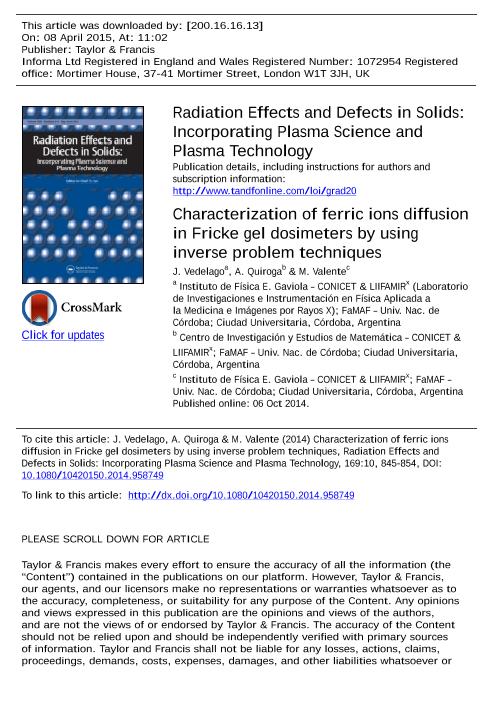Mostrar el registro sencillo del ítem
dc.contributor.author
Vedelago, José Alberto

dc.contributor.author
Quiroga, Andrés Agustin Ignacio

dc.contributor.author
Valente, Mauro Andres

dc.date.available
2017-12-28T18:36:39Z
dc.date.issued
2014-10
dc.identifier.citation
Valente, Mauro Andres; Quiroga, Andrés Agustin Ignacio; Vedelago, José Alberto; Characterization of ferric ions diffusion in Fricke gel dosimeters by using inverse problem techniques; Taylor & Francis Ltd; Radiation Effects And Defects In Solids; 169; 10; 10-2014; 845-854
dc.identifier.issn
1042-0150
dc.identifier.uri
http://hdl.handle.net/11336/31855
dc.description.abstract
Diffusion of ferric ions in ferrous sulfate (Fricke) gels represents one of the main drawbacks of some radiation detectors, such as Fricke gel dosimeters. In practice, this disadvantage can be overcome by prompt dosimeter analysis, and constraining strongly the time between irradiation and analysis, implementing special dedicated protocols aimed at minimizing signal blurring due to diffusion effects. This work presents a novel analytic modeling and numerical calculation approach of diffusion coefficients in Fricke gel radiation sensitive materials. Samples are optically analyzed by means of visible light transmission measurements by capturing images with a charge-coupled device camera provided with a monochromatic filter corresponding to the XO-infused Fricke solution absorbance peak. Dose distributions in Fricke gels are suitably delivered by assessing specific initial conditions further studied by periodical sample image acquisitions. Diffusion coefficient calculations were performed using a set of computational algorithms based on inverse problem formulation. Although 1D approaches to the diffusion equation might provide estimations of the diffusion coefficient, it should be calculated in the 2D framework due to the intrinsic bi-dimensional characteristics of Fricke gel layers here considered as radiation dosimeters. Thus a suitable 2D diffusion model capable of determining diffusion coefficients was developed by fitting the obtained algorithm numerical solutions with the corresponding experimental data. Comparisons were performed by introducing an appropriate functional in order to analyze both experimental and numerical values. Solutions to the second-order diffusion equation are calculated in the framework of a dedicated method that incorporates finite element method. Moreover, optimized solutions can be attained by gradient-type minimization algorithms. Knowledge about diffusion coefficient for a Fricke gel radiation detector is helpful in accounting for effects regarding elapsed time between dosimeter irradiation and further analysis. Hence, corrections might be included in standard dependence of optical density differences and actual, non-diffused, absorbed dose distributions. The obtained values for ferric ion diffusion coefficient are around 0.65 mm2 h−1, being in good agreement with previous works corresponding to similar Fricke gel dosimeter compositions. Therefore, more accurate 2D and 3D dose mapping might be attained, thus constituting valuable improvements in Fricke gel dosimetry, and parallely a high precision method of diffusion modeling and calculation has been developed.
dc.format
application/pdf
dc.language.iso
eng
dc.publisher
Taylor & Francis Ltd

dc.rights
info:eu-repo/semantics/openAccess
dc.rights.uri
https://creativecommons.org/licenses/by-nc-sa/2.5/ar/
dc.subject
Fricke Gel Dosimetry
dc.subject
Ferric Ions Diffusion
dc.subject
Finite Elements Modeling
dc.subject
Radiotherapy
dc.subject.classification
Astronomía

dc.subject.classification
Ciencias Físicas

dc.subject.classification
CIENCIAS NATURALES Y EXACTAS

dc.title
Characterization of ferric ions diffusion in Fricke gel dosimeters by using inverse problem techniques
dc.type
info:eu-repo/semantics/article
dc.type
info:ar-repo/semantics/artículo
dc.type
info:eu-repo/semantics/publishedVersion
dc.date.updated
2017-12-26T20:40:51Z
dc.journal.volume
169
dc.journal.number
10
dc.journal.pagination
845-854
dc.journal.pais
Reino Unido

dc.journal.ciudad
Londres
dc.description.fil
Fil: Vedelago, José Alberto. Consejo Nacional de Investigaciones Científicas y Técnicas. Centro Científico Tecnológico Conicet - Córdoba. Instituto de Física Enrique Gaviola. Universidad Nacional de Córdoba. Instituto de Física Enrique Gaviola; Argentina. Universidad Nacional de Córdoba. Facultad de Matemática, Astronomía y Física; Argentina
dc.description.fil
Fil: Quiroga, Andrés Agustin Ignacio. Universidad Nacional de Córdoba. Facultad de Matemática, Astronomía y Física; Argentina
dc.description.fil
Fil: Valente, Mauro Andres. Consejo Nacional de Investigaciones Científicas y Técnicas. Centro Científico Tecnológico Conicet - Córdoba. Instituto de Física Enrique Gaviola. Universidad Nacional de Córdoba. Instituto de Física Enrique Gaviola; Argentina. Universidad Nacional de Córdoba. Facultad de Matemática, Astronomía y Física; Argentina
dc.journal.title
Radiation Effects And Defects In Solids

dc.relation.alternativeid
info:eu-repo/semantics/altIdentifier/doi/http://dx.doi.org/10.1080/10420150.2014.958749
dc.relation.alternativeid
info:eu-repo/semantics/altIdentifier/url/http://www.tandfonline.com/doi/abs/10.1080/10420150.2014.958749
Archivos asociados
